

D.H. Lawrence, (David Herbert Lawrence), was born in Eastwood, Nottinghamshire, in 1885, and lived in Eastwood for over half of his life, before leaving to take up a position as a schoolteacher in Croydon, but he is best known as a writer, (or author). The header picture, above, shows the view that Lawrence would have seen from the house that he lived in on Walker Street, after the family moved from their second home, which was the Breach House. The lane you can see to the left of the picture, which is still there, is where Lawrence would have walked to visit Jessie Chambers at Haggs Farm in Underwood.
D.H. Lawrence is described as being 5 feet 9 inches tall, (1.75 metres), very thin, pale skinned, having strikingly red hair, and a red beard. The image below of Lawrence is from an old black and white photograph that I have digitally coloured to try and match the descriptions given of Lawrence.
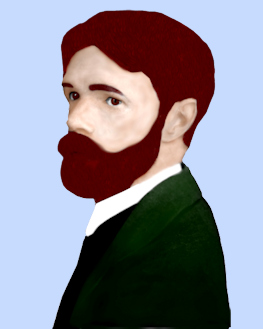
My name is Gavin Gillespie, I was born, and still live in the Eastwood area, and just like Lawrence, I have roamed the same countryside that he loved so much. Thanks for visiting, and I hope that you enjoy this site.
This site contains photographs, mostly taken by me, and information about D.H. Lawrence's Eastwood, including the surrounding areas of Nottinghamshire and Derbyshire. This site also includes many local places mentioned by Lawrence in his novels, including Cossall, Greasley, Moorgreen, Brinsley, Underwood, Newthorpe, and Giltbrook. Please use the links at the bottom of this page for contact details and further information. The images, and also the textual content of this site, must not be copied for use in any other website, or publication, without prior consent.
This site was previously listed as gavingillespie.co.uk but was rebranded as dh-lawrence.co.uk in 2024.
I do not personally collect any information, or data, about visitors to this site,
and all the information on this site is supplied mostly by my research,
and at my expense, so there should be no requests for any form of payment on here, either directly or indirectly.
External Links:- Any information provided on external links is beyond my control, and external links are only
provided to known sympathetic and trusted websites.
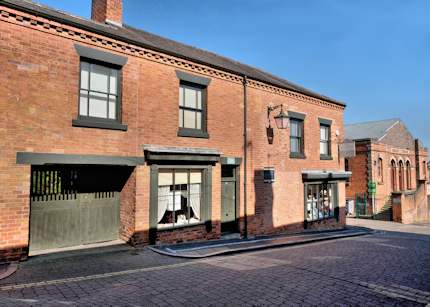
D.H. Lawrence's birthplace is now a museum, and has been converted back to how it would have looked when Lawrence was a child. The bedroom, above the shop window in the picture, is the actual room where Lawrence was born. Lawrence's full name was David Herbert Richards Lawrence, but he was always known as Bert. He was born in this small terraced house, at 8a Victoria Street, in Eastwood, Nottinghamshire, on the 11th. of September 1885
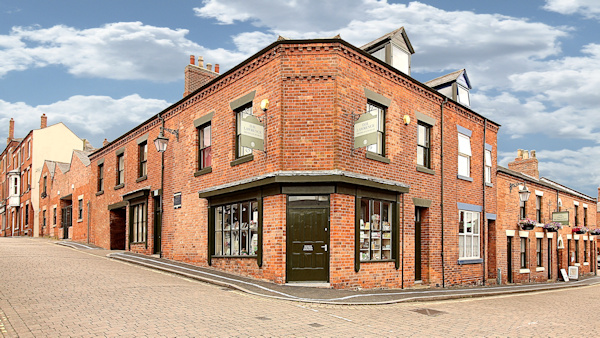
This photo above shows the D.H. Lawrence Birthplace Museum, which is attached to the house where Lawrence was born. Both properties have been lovingly restored, mostly with original items from the time when Lawrence was alive. Entry to the actual birthplace is through the Museum main entrance. The properties to the right of the Birthplace Museum have been restored, and converted, to provide a craft centre in keeping with area.
The D.H. Lawrence Birthplace Museum is situated at 8a Victoria Street, Eastwood, Nottingham, UK. Postcode NG16 3AW. This is just off the main Nottingham Road, and only a few seconds from Eastwood town center. Carolyn Melbourne is the Museum and Collections Officer at the Birthplace Museum
For opening times of the D.H. Lawrence Birthplace Museum, admission charges, times of guided tours, or any other details, telephone 0115 917 3824, or click on the following link, which takes you to the Broxtowe Borough Council website who fund and manage the Museum.
D.H. Lawrence Birthplace Museum
The Museum Facebook page is on the following link:-
D.H. Lawrence Birthplace Museum Facebook page.
The quotes below are from Alfred Johnson, aged 65, a garage hand at Leivers Garage, (which was just above Lawrence's birthplace), speaking in 1960 about life in Eastwood when D.H. Lawrence was a child:-
"Until 1900, the women fetched water from a stream a quarter of a mile away at the bottom of the hill. They would return with the buckets swinging on the yokes that normally hung outside nearly every home."
"William Leivers had a cart with a barrel on it in which he fetched water from the stream, selling it for a farthing a bucket. On Fridays, the butchers would kill a beast in their shops, swill the floor, and hang the head outside as a sign to the women to come and get their weekend meat."
(In 1900, there would have been 960 farthings in an English Pound).
This is a quote by D.H. Lawrence, from about 100 years ago, and even in these modern times, it is still so pertinent.
"Men fight for liberty and win it with hard knocks. Their children, brought up easy, let it slip away again, poor fools. And their grand-children are once more slaves"
Lawrence was the fourth child born into the family, and later lived in various properties around the Eastwood area, first moving to the Breach house in 1887, when he was two, (now number 28 Garden Road). The house is shown on the left hand side in the picture below. The house is situated in a row of 6 blocks, and the blocks are all still standing, the blocks were referred to as 'The Bottoms' in the novel, 'Sons and Lovers'. The Breach House now has monthly open days between April and September, and is also open for occasional special events. There is a browsing library upstairs which contains over 200 books written by, or about, DH Lawrence, and outside, the gardens have been planted with all the flowers mentioned in the Sons and Lovers book, along with descriptions of them.
Further information about the Breach House, including opening times, is available on this website from the following link
Breach House opening times.
To contact The Breach House directly:- Telephone 07875 121936, or email, hallbotanical@hotmail.com
The Breach House Website link:- The Breach House
The immediate Lawrence family consisted of:-
Arthur Lawrence 1847 - 1924
Lydia Lawrence 1852 - 1910
George Lawrence 1876 - 1967
William Ernest Lawrence 1878 -1901
Emily Lawrence 1882 -1962
David Herbert Lawrence 1885 - 1930
Lettice Ada Lawrence 1887 - 1948
In 1891, the Lawrence family moved into what is now number 8 Walker Street, where they lived for 12 years. The exact house did seem to be a bit of a mystery, but was described by Lawrence as the third house in the block, which, if walking from Eastwood town center, would now be number 8. When I checked the Census records for 1901, they indicated that the houses had not been numbered at that time, but when Lawrence, at the age of 16, applied for employment as a clerk, he gave his address as number 3 Walker Street, this again confirmed to me that the house is now number 8, as this would have been the third house in that terraced block, counting from the main road through Eastwood town center, which was the way that other houses had been numbered.
Since writing the above, I have now spoken to the owner of number 8 Walker Street, and she has confirmed that Lawrence did in fact live there, (even though the official plaque is attached to number 10). If visiting the area, please remember that number 8 Walker Street is a private residence, and respect the owners privacy.
In the 1901 UK Census the inhabitants of the Walker Street property
were listed as:-
Arthur Lawrence : aged 53 : Occupation - miner.
Lydia Lawrence : aged 48 (wife)
Emily Lawrence : aged 19 (daughter)
David H Lawrence : aged 15 (son)
Lettice Lawrence : aged 13 (daughter)
William G Lawrence : aged 3 (grandson)
I think the grandson, William G Lawrence, would have been George's son.
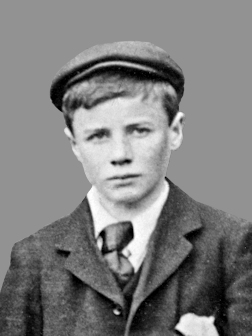
The picture below, shows the terraced block of bay-windowed houses on Walker Street. The house in the middle of the terrace, (third bay window from the right), is the house where the Lawrence's lived, and where D.H. Lawrence said he would look across the fields from the bedroom window above towards Crich, in Derbyshire, Brinsley, and Underwood.
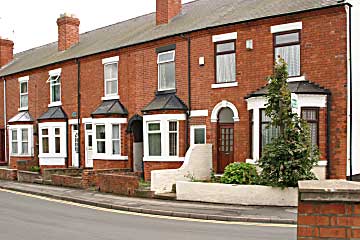
The view of the Eastwood countryside, below, is the actual view that Lawrence would have seen from the front of the house on Walker Street. It shows the lane leading up to Coney Grey Farm, with the village of Underwood, just visible on the skyline.
This is how D.H. Lawrence described this view from Walker Street in 1926:-
"Go to Walker Street and stand in front of the third house - and look across at Crich on the left, Underwood in front - High Park woods and Annesley on the right: I lived in that house from the age of 6 to 18, and I know that view better than any in the world." - "That's the country of my heart."
This picture was taken by me in May 2005, since then, a school has been built in front of, and obstructing the view that Lawrence loved, ironically, that school has been named The Lawrence View School.
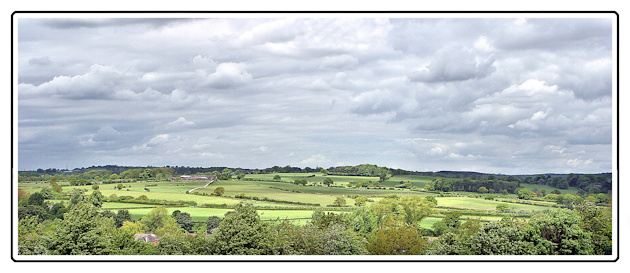
The Lawrence's final family home in Eastwood was at what is now known as number 97 Lynncroft, although in the letters that D.H. Lawrence wrote from the house at that time, it was then known as 97 Lynn Croft. This house, (pictured below), is on the road which adjoins the Breach, and Walker Street, and is about 300 metres away from the previous home. The house is a semi-detached property, and might have been seen as a further step up the social ladder for Lydia Lawrence, but it did not have the magnificent panoramic views of the previous house on Walker Street, it was at the top of a steep hill, but the view was partially obscured by other houses on each side of the street. The significance between Lawrence and 97 Lynncroft is often understated, this is the house where his early relationships blossomed, moulding characters from those relationships to use in his early novels, including Sons and Lovers, The Rainbow, and Women in Love.
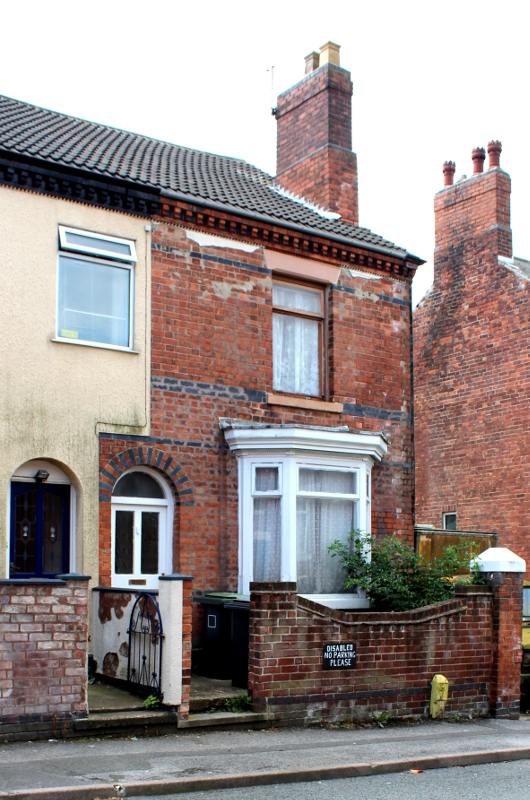
D.H. Lawrence lived at number 97 Lynncroft for just over 5 years. He wrote several letters from Lynncroft in 1903, the first ones appear to have been in October, when he had just turned 18, including one to Jessie Chambers, at Haggs Farm in nearby Underwood, when he commented about an earlier visit they had both made to Nottingham's Goose Fair. Jessie Chambers was later the inspiration for his character, Miriam Leivers, in his semi-autobiographical novel, Sons and Lovers.
Five years later, during October 1908, when aged 23, Lawrence wrote to his then fiance, Louie (Louisa) Burrows, at Church Cottage, Cossall, from 97 Lynncroft, telling her that he had just received confirmation of his new appointment as a teacher in Croydon. Louie Burrows was the inspiration for Ursula Brangwen in Lawrence's novels, The Rainbow, and Women in Love.
D.H. Lawrence returned to the Lynncroft house in 1910, when his mother was dying, and was with her at the house, holding her hand, when she died, aged 58, on the 9th. December, 1910.
As of April 2023, this house is in very poor condition, and was recently sold by auction for £91,000. The auctioneers were Auction House London, and auctioneer, Andrew Binstock, of 'Homes Under The Hammer' fame, was very helpful in explaining the historical importance of the house both before, and during the auction. Hopefully, whoever purchased the house will now give it the love and attention it is craving for. In my opinion, this house, and the surrounding areas, would probably have had the biggest influence on Lawrence's early novels, being the time that he was socially, and romantically, involved with both Jessie Chambers, and Louie Burrows.
I have now been informed that a planning application has been submitted to Broxtowe Borough Council regarding D.H. Lawrence's former home at 97 Lynncroft, Eastwood, the application is to convert the property into a house of multiple occupation. The planning application number is Ref: 23/00512/FUL
When the house was sold by Auction House London recently, it was hoped that whoever purchased the property would restore it to be more in keeping with the lovely house that Lawrence once loved, but if the planning application is successful, it now seems destined to be turned into several bedsits over all three floors of the property, which is hardly befitting of a property with such an historical past, and which is regularly viewed by many visitors to Eastwood. Hopefully, this planning application will be refused, and the buyer will be reminded of the property's historical significance, a point that was made quite clear both before, and during the auction by auctioneer, Andrew Binstock.
In March, 2024, I discovered an unusual coincidence regarding D.H. Lawrence, and Thomas Henry Fisher, thanks to David and Jim Schutte, and Eddie Muir, for providing me with the following information.
Thomas Henry Fisher was born on Lynn Croft, at Eastwood, Nottinghamshire, on the 30th. of June, 1879, six years before Lawrence. The number of the house where he was born is not known, but is thought to be near to number 97, where D.H. Lawrence later lived with his family from 1903 to 1908, so two people, both famous in the literary world, were born in Eastwood in the late 1800's, and only six years between each other. Thomas Henry Fisher, was the illustrator of many publications of that time, including cartoons for the satirical magazine, Punch, but is most well known as Thomas Henry, the illustrator of the Just William books, written by Richmal Crompton, he died in 1962.
The source of the above information regarding Thomas Henry Fisher's birthplace is from his birth certificate.
In the 1911 UK Census, and not long after Lydia had died, Arthur Lawrence is shown to be living with his daughter, Emily, at Bromley House, which is on Queens Square at Eastwood, along with Emily's husband, Samuel King, and her younger sister, Lettice Ada, who is listed as a school teacher.
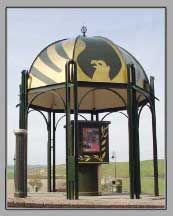
This memorial to D.H. Lawrence is situated near to the Sun Inn pub at Eastwood, which is on the junction of Nottingham Road, Mansfield Road, and Derby Road.
Lawrence's early education was at Greasley Beauvale Board School, near Eastwood, and later, after winning a scholarship in 1898, he attended Nottingham High School. He also studied at Nottingham University and spent a brief time teaching at the Davidson Road school, in Croydon, South London.
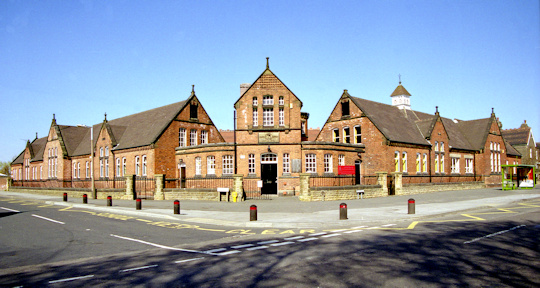
Lawrence's father, Arthur John Lawrence, was born at Quarry Cottage, Brinsley, on the 18th. June 1847, and when Bert Lawrence was born, worked as a coal miner at nearby Brinsley Colliery. The picture below was taken underground at Brinsley Colliery in 1970, and shows the terrible conditions that miners would have worked in hundreds of metres below the ground. The height of the roof appears to be less than 70 centimetres, (27 inches), and is totally unsupported.
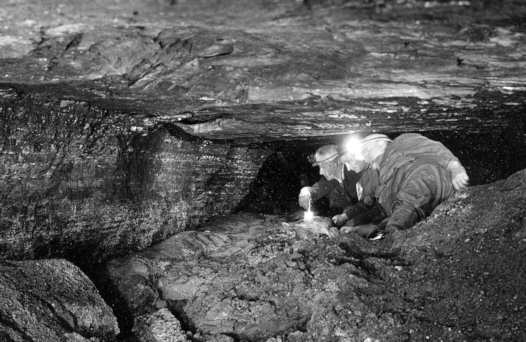
D.H. Lawrence's mother, Lydia (nee Beardsall), was born in Ancoats, Manchester on the 19th. July 1852, although her father was originally from a Nottinghamshire family. Lydia sold haberdashery from the Lawrence's front room shop on Victoria Street to help feed and clothe the family. The dates of birth of Lawrence's parents seem to vary depending on which source is used, but the above dates fit in with the dates on their gravestone, and the 1901 Census. Arthur John Lawrence married Lydia Beardsall at Sneinton Parish Church, Nottinghamshire on the 27th December 1875.
Arthur Lawrence is often described as illiterate, but the position that he held down the mines, where he was in charge of a gang of men, and also his choice of wife, seems to indicate that he was far from being unintelligent. His job down the mine entailed working with, and supervising, a group of other miners, as they hacked out the coal by hand. That amount of coal would be measured, and Arthur would be paid at the end of the week, for the exact amount of coal that his group of men mined, it would then be up to him to share out this money fairly between the other men.
Lydia came from a middle class religious family, and the differences in Lawrence's parents backgrounds often led to family conflicts, with his father preferring to spend his wages on drink, possibly to help deaden the pain of working long grueling hours underground, whilst his mother was more concerned with the children's upbringing, welfare, and education. Lydia also had ambition, and wanted to own a shop on the main Nottingham Road in Eastwood, but with a growing family, this proved beyond reach.
A quote from Professor J David Chambers, former Professor of Economic History at Nottingham University, and brother of Jessie Chambers, speaking in 1960:-
We had very little sympathy for Mrs. Lawrence. She felt herself superior to her husband and was jealous of Jessie. Mr Lawrence, although he drank, was a very respected man.
The conflict between his parents resulted in Lawrence seemingly hating his father, possibly blaming him for the poverty and violence that his lifestyle inflicted upon the family. He once wrote in a letter to the poet Rachel Annand Taylor, "I was born hating my father, as early as ever I can remember, I shivered with horror when he touched me."
Lawrence's loathing of his father, also probably extended to the mining community in which he grew up, and perhaps to some of the Eastwood community itself. Most of the people of Eastwood did not accept Lawrence, and his name was hardly mentioned in the town for many years because of the perceived disgrace his novels had brought upon the community. Once, when Lawrence returned to visit Eastwood after he became famous, he was asked if he would like to live there again, and he replied, "I hate the damn place", but in an essay he wrote in 1929, his views seem to have softened slightly.
As a gifted, well educated child, he would not have fitted in well with most of the children from the other mining families, and he would probably have been cruelly bullied because of his superior talents, which elevated him above most of the other children.
Thomas Paxton-Kirk, who went to school with Lawrence, commented when reading about the 1960's obscenities trial of Lady Chatterley's Lover, 'I went to school with him and he were a right cissy, allus playin with the girls'. Another former pupil, in 1960, commented on Lawrence's days at Beauvale Board School saying, 'He was followed in the playground by mobs of boys shouting Dicky Dicky, Denches, plays with the wenches'. (I am not sure what the word, Denches meant, as I have not heard it mentioned before), but Dicky would probably refer to his third name,which was Richards, and wenches refers to girls.
Even though he does not seem to have liked what mining did to Eastwood itself, and probably how he was treated at school, Lawrence loved the beautiful countryside surrounding Eastwood, describing it as, 'the country of my heart', and this, combined with the stark contrast of the mining industry, was the inspiration for his early novels, including 'The White Peacock' and 'Sons and Lovers'
In 1918, when Lawrence was asked what he thought about Eastwood, he replied, "Eastwood - For the first time in my life I feel quite amiably towards it. I have always hated it, now I don’t".
What did DH Lawrence really think about Eastwood, and England? Check the following link.
An essay written by D.H. Lawrence, about Eastwood, in 1929.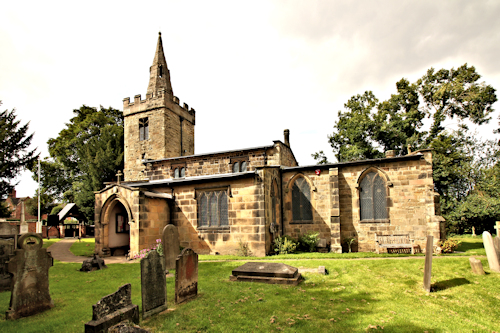
Cossall is near to Eastwood, with Cossethay, and Cossethay Church, being mentioned often in The Rainbow. Tom Brangwen had obtained a cottage near to Cossethay Church for Anna Lensky and Will Brangwen to live in when they were married, the view from the cottage being described below.
"Looking out through the windows, there was the grassy garden, the procession of black yew trees down one side, and along the other sides, a red wall with ivy separating the place from the high-road and the churchyard. The old, little church, with its small spire on a square tower, seemed to be looking back at the cottage windows. 'There'll be no need to have a clock' said Will Brangwen, peeping out at the white clock-face on the tower, his neighbour."
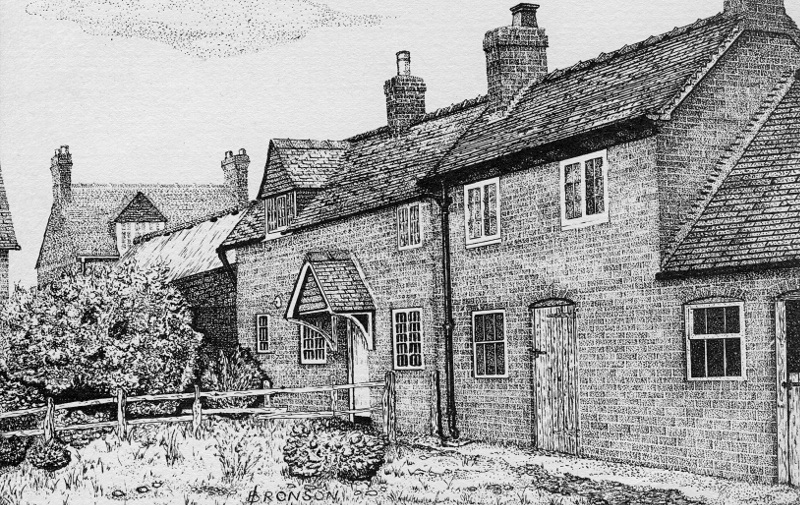
This drawing, of Haggs Farm at Underwood, is by Jack Bronson, copied from a postcard that I acquired recently. I have been informed by Clive Leivers, of the Haggs Farm Preservation Society, that sadly, Jack died a few years ago.
Uninvited visitors are not encouraged, or permitted at this farm, so please respect the owner's privacy.
As a young man, Lawrence would often walk from Eastwood to visit Jessie Chambers, who lived at Haggs Farm, in nearby Underwood, and it was at Haggs Farm that Lawrence said that he got his first incentive to write.
The Chambers family lived at the farm from 1898 to 1910, and Jessie's brother, Jonathan David Chambers, (1898-1970) later became Professor of History at University College Nottingham, where he, along with Professor Vivian de Sola Pinto, played a major role in promoting the work of Lawrence at the University, and also collecting Lawrence related material for the University of Nottingham Library. Jessie Chambers was later to become fictionalised as Miriam Leivers in Sons and Lovers, with Haggs Farm being called Willey Farm in Sons and Lovers, and Strelley Mill in The White Peacock.
To see many more pictures of Haggs Farm, including pictures of Jessie Chambers and the rest of the family, and also details of how to join the Haggs Farm Preservation Society, visit my Haggs Farm page on the link below
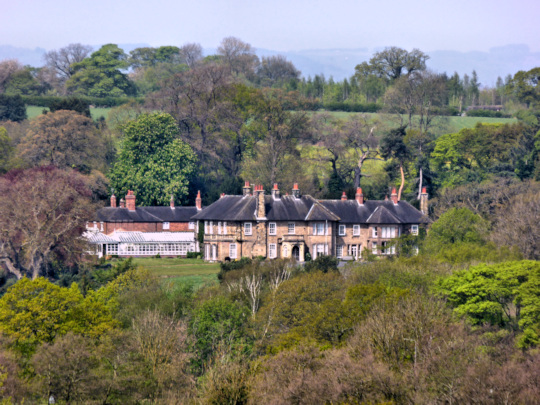
Lamb Close House is a Grade II listed building in Greasley, Nottinghamshire. It has been the home of the Barber family for over 200 years. This building is not accessible to the general public, and uninvited visitors are not encouraged.
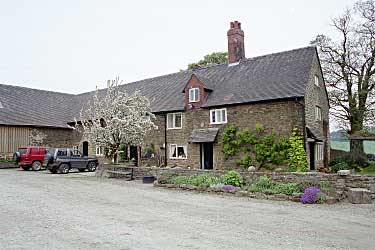
D.H. Lawrence would have passed this farm as he walked across the fields to Underwood, and his novel, Lady Chatterley's Lover, is said by local people to be set in the area around the farm.
Lawrence's writing often confuses local people with the names he gave to some of the buildings and places in his novels. He would sometimes name them after a place, or building, which was situated near to the actual place that he was writing about. Willey Farm is an example of this, as Willey Wood Farm is an actual farm, only a short distance from Haggs Farm, and which Lawrence would pass on his walks to visits Jessie Chambers.
Lawrence's dearly beloved mother died of cancer, in 1910, with Lawrence reported to have given her an overdose of 'sleeping medicine', to end the pain that she was suffering. His father died in 1924, aged 77. They are buried, along with Lawrence's brother William, in the family grave, pictured below, in Eastwood Cemetery, which is situated at the bottom of Church Street.
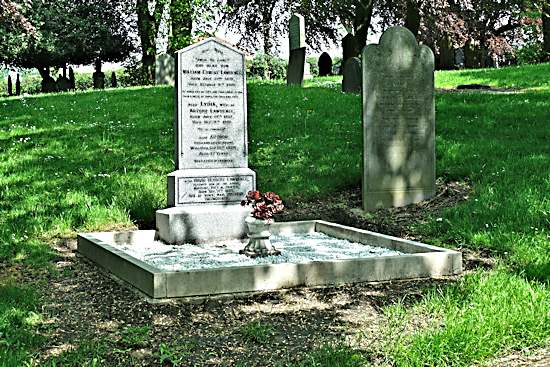
Here Rests
"Until He Come"
Our Dear Son
William Ernest Lawrence.
Born July 22nd. 1878.
Died October 11th. 1901.
He asked life of thee, and thou gavest it him,
Even length of days, for ever and ever.
-
Also Lydia, wife of
Arthur Lawrence,
Born July 19th. 1852,
Died Dec. 9th. 1910.
"It is Finished"
-
Also Arthur,
Husband of the above,
Who Died Sept. 10th. 1924,
Aged 77 years.
Rest After Weariness
Then the inscription continues, implying rather mysteriously, and incorrectly, that D.H. Lawrence is buried here, stating:-
Also David Herbert Lawrence,
Beloved Son Of The Above,
Novelist, Poet and Painter,
Born Sept. 11th. 1885.
Died at Vence, Mar. 2nd. 1930.
UNCONQUERED.
The inscription on the gravestone, (or headstone), was restored in May, 2023. This was necessary as it was fading badly, and was funded by the D.H. Lawrence Society, with a contribution from Broxtowe Borough Council.
Another quote by Lawrence, showing that even a Century later, we have still not evolved.
"Ours is an excessively conscious age. We know so much, we feel so little."
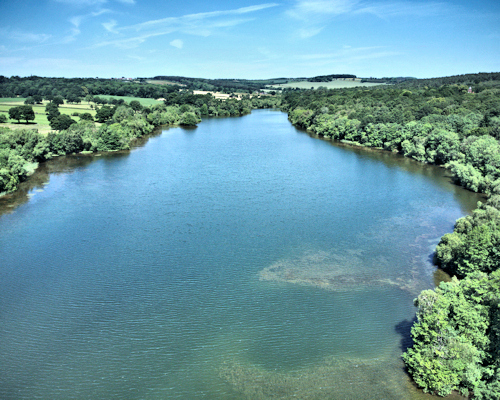
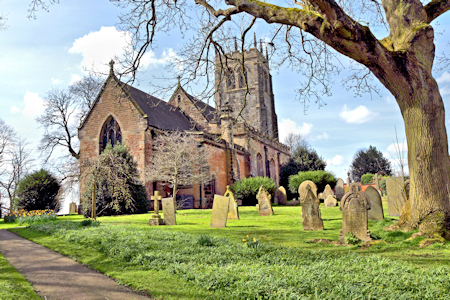
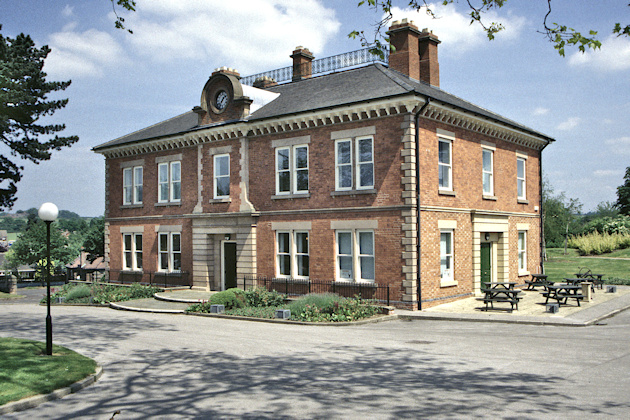
Durban House was built in 1896, for The Barber Walker mining company, and was once the wages offices for Brinsley Colliery, where D.H. Lawrence's father worked. This building is also where a young Bert Lawrence would visit to collect his fathers pay packet. The house was then turned into a mining officials institute, with a concert hall, billiard table, and library, and later converted into apartments for the local community.
In 2022, Durban House took on its new role as a Community Hub, and has now been awarded charity status. This will enable all those concerned with the local community to expand their range of projects, and to benefit Eastwood and the surrounding areas.
As of May, 2024, Durban House is being refurbished, and rumours are circulating that it is to be used as the offices for a well known company.
The latest information about the Durban House Community Hub, including the services it now provides, along with contact information, is available on a separate page of this website from the following link.
Durban House Community Hub.Sadly, during January 2024, due to decay in the timbers of the wooden structure, the Headstocks were dismantled, cut up, and removed from the site. We are now waiting to see what is to become of this very popular area.
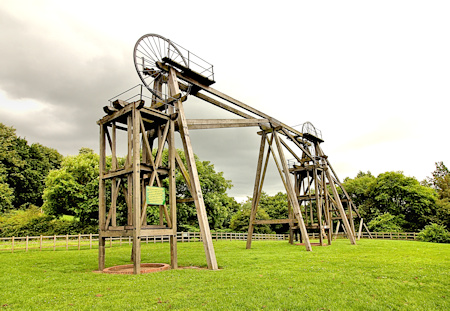
In 1912, Lawrence met and fell in love with Frieda Weekley, (nee von Richthofen). Frieda, who was the wife of Ernest Weekley, a professor at Nottingham University, left her husband, and three children to be with Lawrence, and they traveled to Bavaria, Austria, Germany and Italy, before returning back to England.
D.H. Lawrence married Frieda at Kensington Registrar's Office, in London, on the 13th. July 1914, shortly after her divorce from Ernest Weekley. The witnesses at the wedding were Katherine Mansfield and John Middleton Murry.
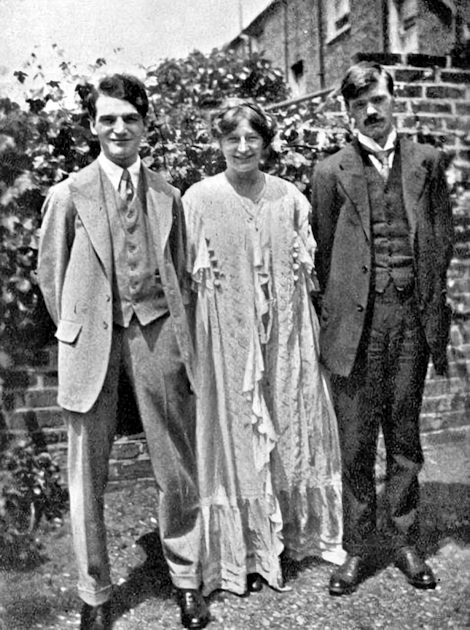
They had intended to return to Italy in August, but this was prevented by the outbreak of the first world war, trapping the couple in England. They moved to Cornwall, staying at Tregerthen Cottage in Zennor, but living near the south coast, and overlooking the British shipping lanes, with a German wife, and with Britain at war with Germany, this only served to compound Lawrence's problems.
These were very troubled times for the couple, They were both accused
of spying for Germany, and Lawrence's novel, 'The Rainbow', was banned for
its alleged obscenity, with over 1000 copies of the book being destroyed on
the orders of the Bow Street magistrates. This caused great financial
hardship to Lawrence, and damaged his chances of getting further novels
published in England.
It was hardly surprising that Frieda was mistrusted in Cornwall, she and Lawrence were often heard singing German songs as they walked along the cliffs, and her cousin was the German pilot, and air ace, Baron Manfred von Richthofen, also known as the Red Baron. Manfred's brother, Lothar von Richthofen, was said to be responsible for the unsubstantiated shooting down, and resulting death, of Captain Albert Ball, Nottingham's very own air ace.
Lawrence and Frieda were expelled from Cornwall in 1917, because of the spying allegations, and with not a penny to their name, they returned to London, where they were looked after by friends. Later Lawrence's sister Ada, came to their rescue, paying the rent for them at Mountain Cottage, near Middleton-by-Wirksworth, in Derbyshire, where they stayed until 1919,
A quote by Professor Vivian de Sola Pinto, former Professor of English, at Nottingham University.
"Lawrence had the extreme bad luck to marry the daughter of a German general at the height of the wave of of anti-German feeling. This combined with his outspokenness on sex was too much for the puritanical history of the English, which periodically asserts itself."
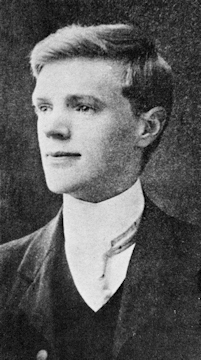
D.H. Lawrence had left Eastwood in 1908, shortly after this picture was taken, and 11 years later, after the first world war had ended, he left England. At this time he was greatly disillusioned, after being persecuted for his 'obscene' style of writing, and also because of his marriage to Frieda. He lived in various countries around the world during his relatively short life, including France, Switzerland, Italy, Austria, Australia, Ceylon, and New Mexico in the USA. Lawrence returned to England briefly in 1923, to spend Christmas with his sisters, before returning back to New Mexico. I can find no record of him attending his father's funeral, in 1924.
Lawrence returned to Italy, from New Mexico, staying in Florence, and it was here that he wrote the novel, 'Lady Chatterley's Lover'. This was the novel that was to posthumously make him a household name, all around the world. Lady Chatterley's Lover was published in England in 1960, thirty years after Lawrence's death. The publishers, 'Penguin Books', were prosecuted under the Obscene Publications Act 1959, but after a lengthy trial, in which many eminent authors were called by the defence lawyers as witnesses, Penguin Books were acquitted.
Lady Chatterley's Lover was released into the bookshops, and the paperback version was quickly snapped up by queues of buyers, eager to see what all the fuss had been about. The controversial swear words, and sexually descriptive passages, were easily found in used copies of the book, either by the finger marks on the edges of the pages, or by just letting the pages of the book fall open.
D.H. Lawrence last visited England, and the Eastwood area, in August, 1926. Lawrence died of tuberculosis in Vence, France, less than 4 years later, on the 2nd. March 1930, aged 44. He was buried in the old Vence cemetery, but his body was later exhumed in March 1935, at the request of Frieda. His remains were cremated at Marseilles, ready to be taken by boat to Taos, in New Mexico, but there is speculation as to whether the ashes arrived at their destination.
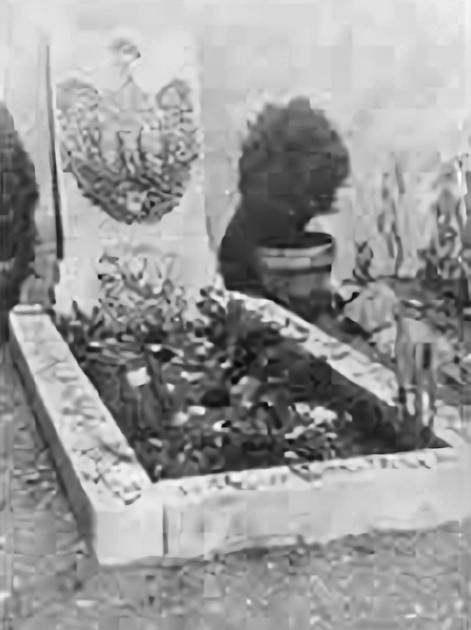
This image is from the Nottingham University archives, but it has been enhanced, and enlarged for this website.
D.H. Lawrence's gravestone, (pictured below), headstone, or tombstone, as it could be known in other countries, was constructed as a concrete base, with beach pebbles fashioned into the shape of a phoenix, and measures 24in. x 18in. (61cm. x 46cm.). The stone was removed from the cemetery in Vence after Lawrence's exhumation, and later transported to England by Mrs. Gordon-Crotch, where it was rescued by Professor Vivian de Sola Pinto, who then delivered it to Eastwood Council in 1957. The gravestone is now on display in the D.H. Lawrence Birthplace Museum, at Victoria Street in Eastwood.
This gravestone was previously housed at Eastwood Library, and I would like to give a special mention to Pat Bonsall of Eastwood Library, for the excellent help and co-operation given when taking this image. Eastwood Library now hosts a comprehensive selection of literature written by Lawrence, and also about Lawrence.
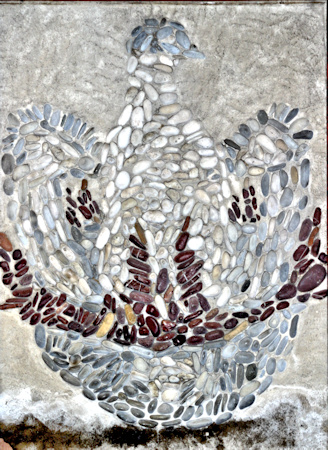
Frieda Lawrence designed the gravestone, and it was constructed by a local craftsman using coloured beach pebbles placed in a soft mortar mix. When Virginia Woolf, a friend of Lawrence, visited the grave, she is said to have remarked that it looks like a kind of plum pudding, adding, "What a fate for a man who loved beauty".
The phoenix bird, depicted on the headstone, was probably inspired by the following paragraph, taken from Lawrence's book, The Rainbow, where Will Brangwen had carved a wooden butter stamper for Anna Lensky, which she used to imprint the phoenix symbol on the butter made at the farm, as a form of trademark.
"The first thing he made for her was a butter-stamper. In it he carved a mythological bird, a phoenix, something like an eagle, rising on symmetrical wings, from a circle of very beautiful flickering flames that rose upwards from the rim of the cup."
"Anna thought nothing of the gift on the evening when he gave it to her. In the morning, however, when the butter was made, she fetched his seal in place of the old wooden stamper of oak-leaves and acorns. She was curiously excited to see how it would turn out. Strange, the uncouth bird moulded there, in the cup-like hollow, with curious, thick waverings running inwards from a smooth rim. She pressed another mould. Strange, to lift the stamp and see that eagle-beaked bird raising its breast to her. She loved creating it over and over again. And every time she looked, it seemed a new thing come to life. Every piece of butter became this strange, vital emblem."
Further quotes about Lawrence by Professor Vivian de Sola Pinto, former Professor of English at Nottingham University:-
He was very well educated in the tradition of provincial, nonconformist, working class culture, which is very different from the public school, Oxford and Cambridge culture, but just as important. He knew French, Latin, and German, and could have been a very scholarly man if he had so desired. He knew the Bible backwards and in this respect, as in many others, was similar to Bunyan.
Lawrence was one of the greatest of English writers. He was one of the great prophetic writers of English literature, ranking with Wordsworth or Blake, and much greater than Melville or Whitman."
Angelo Ravagli, who was now the lover of Lawrence's widow, Frieda, was entrusted with the task of bringing Lawrence's remains, in the beautiful vase which Frieda had provided, from Southern France, and return him to New Mexico.
Later, when back in New Mexico, and after drinking with his guests, the de Haulleville's, Ravagli confessed to throwing away Lawrence's ashes between Villefranche and Marseilles, before sailing on the 'Conde di Savoiain' to New York. This was to save him from the trouble, and expense, of shipping the ashes to the USA. He said that he had mailed the vase from Marseilles to New York, and then, after arriving in New York, put some local ashes in the vase, before taking the vase to Taos. He later had those ashes made into a concrete slab, which became Lawrence's shrine, at the Kiowa ranch, at San Cristobal, near Taos. So it seems that despite Frieda's wishes, and popular belief, D.H. Lawrence's remains were scattered across the fields of France, near to the Rhone river, or even deposited into the Mediterranean Sea, to be dispersed around the world by the winds and tides, which in retrospect, was probably much more in keeping with Lawrence's philosophy.
D.H. Lawrence's last words, before he died in Vence, are said to have been, "I'm getting better". It is reported that only ten people attended Lawrence's funeral, one of those mourners being Aldous Huxley, another author.
The factual details on this site have been compiled from several sources, and the validity of this information cannot be guaranteed.
A very well respected biographer of D. H. Lawrence is John Worthen, who was Professor of D.H. Lawrence Studies, at Nottingham University. Professor Worthen is also the director of the D.H. Lawrence Research Centre. One of his books, 'D. H. Lawrence : The Early Years 1885-1912', which was published in 1991, by the Cambridge University Press, is a 'must read' for anyone wanting to further their knowledge and understanding of Lawrence. His latest biography on Lawrence, 'D.H. Lawrence - The Life of an Outsider', was published in February 2005.
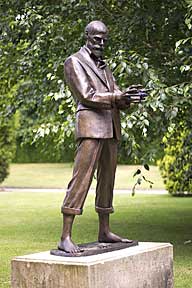
This excellent, life size bronze statue of D.H. Lawrence, sculptured by Diana Thomson FRBS, shows Lawrence holding a blue gentian flower, this flower was chosen from his poem 'Bavarian Gentians'. The statue stands in the Nottingham University grounds, and it can be found outside the Law and Social Sciences building. The statue was unveiled by members of the Lawrence family on the 18th. June 1994.
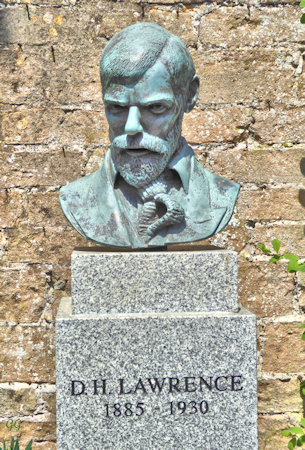
This bust of D.H. Lawrence was also sculptured by Diana Thomson FRBS. It was originally sited at Nottingham Castle, but was moved to Newstead Abbey when the Castle was renovated, and is on display in the Abbey gardens alongside a bust of Lord Byron.
Whilst being the birthplace of D.H. Lawrence, and also having a museum dedicated to him in the house where he was born, we have never had a statue of him for visitors to admire, and photograph to them share with others, we hope to change that, can you help?
A page has been set up to try and raise funds for the creation of a statue to honour D.H. Lawrence's contribution to Eastwood, details on the following link:-
In 1955, an ambitious attempt was made by Eastwood Urban District Council to build a £200,000 Memorial Hall, with a statue outside of the hall dedicated to D.H. Lawrence. The hall was also to contain a swimming pool and other municipal facilities. Further information on the link below.
Some of the reviews of the books are excerpts from outside sources.
The White Peacock (1912)
This was the first novel written by D. H. Lawrence, published in 1911. Lawrence started writing the novel in 1906 and then rewrote it three times. This novel is set in the Eastwood area, where he grew up, and is narrated in the first person by a character named Cyril Beardsall, Beardsall was his mother's maiden name.
The Trespasser (1912)
Sons and Lovers (1913)
This review is from Sarah.
Sons and Lovers is a wonderful novel on the complex nature of love in its many forms. We follow the lives of the Morel family who live in a coal mining community in Nottinghamshire at the turn of the twentieth century.
Walter and Gertrude's marriage has problems and Gertrude concentrates her love and hopes on her sons. She becomes a dominating force to them and the life choices they make. The sons suffer with obsession, frustration and indecision about the women in their lives.
The Widowing of Mrs Holroyd (1914)
The Prussian Officer, and other stories (1914)
The Rainbow (1915)
This is where Lawrence is said to have chosen as the setting for the Brangwen family's farm in his novel, The Rainbow.
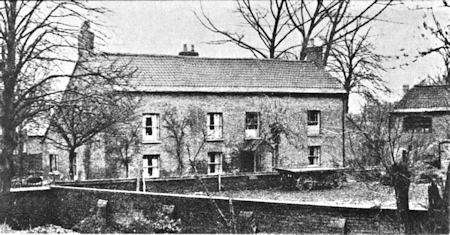
Whilst reading Lawrence's novel, The Rainbow, it made me consider if there was any relationship between the book, and the Rainbow Flag, adopted by the lesbian, gay, bisexual, transgender, LGBT, groups. When I checked on the Internet, I could not find a definitive answer as to why the Rainbow Flag was chosen by the LGBT group, and as Lawrence's novel, The Rainbow, refers to instances of lesbianism, and bisexuality, with Ursula Brangwen having an intimate affair with her teacher, Winifred Inger, is this just a coincidence?
This is what the Smithsonian Institution of New York says, "So the rainbow has only been a queer symbol for the past 40 years? Not necessarily. Even a quick perusal of historical LGBT periodicals and magazines reveals a plethora of colorful references as far back as 1915, many of them in fiction writing. The chronology begins with D.H. Lawrence's The Rainbow, featuring a lesbian affair between a student and a schoolteacher"
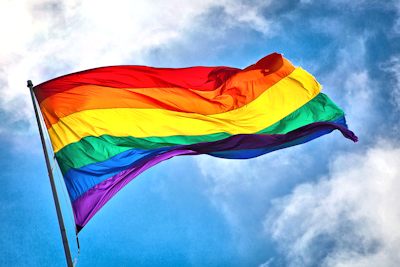
D.H. Lawrence's book, The Rainbow, was originally banned under the Obscene Publications Act when it was first published in the UK in 1915. driving it underground, but it was still available for sale to those who knew where to buy it. With homosexuality, and lesbianism, mostly having to be carried out underground at that time, it would seem to me like a good enough reason for someone to associate the book with the LGBT movement, especially as the earliest versions of multi coloured flags were used in San Francisco in the 1960's, which would be at the same time of the obscenity trial carried out in the UK against Penguin Books, and Lawrence's, Lady Chatterley's Lover. Could it be that Lawrence, and his book, The Rainbow, was the inspiration for the Rainbow Flag, either consciously, or subconsciously?
The following review is from Duane.
The Rainbow was the prequel to Women in Love (1920). It is set in rural England in the early 20th century, and is the story of three generations of the Brangwen family. It deals with themes like love, relationships, family, homosexuality, social mores, religious rebellion, just to name a few. It was originally banned in England for its frank portrayals of sex in nontraditional manners, something that Lawrence would encounter throughout his career.
Twilight in Italy (1916)
Amores (1916)
Look! We have come through! (1917)
Women in Love (1920) (This was the sequel to The Rainbow).
This review is from Cheryl.
This story focuses on feminist sisters, Gudrun and Ursula, and their significant others, Gerald and Birkin. Gudrun and Ursula are teachers who stand apart in society because of their ideals, even by the way they dress and interact with others, (yes, a good shade of pink or yellow jeans in the midst of suits, always symbolizes the middle finger in the air). Is one woman born a mistress? Is the other settling for marriage or choosing love? To think, this was first published in a 1916 male repressive society, and yet these are female characters making such radical lifestyle choices, like Gudrun leaving home to live in London as a single artist.
The Lost Girl (1920)
Sea and Sardinia (1921)
Tortoises (1921)
Aaron's Rod (1922)
Fantasia of the Unconscious (1922)
England, my England and other stories (1922)
The Ladybird, the Fox, the Captain's Doll (1923)
Kangaroo (1923)
Birds, Beasts and Flowers (1923)
The Boy in the Bush (1924)
St. Mawr (1925)
The Plumed Serpent (1926)
Lady Chatterley's Lover (1928)
After the 1960's obscenity trial in the UK, the book sold over 2 million copies within a year.
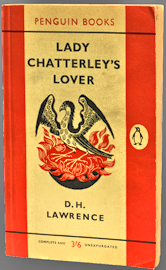
Collected Poems (1928)
Rawdon's Roof (1929)
Pansies (1929)
Nettles
The Virgin and the Gipsy
Love Among the Haystacks
A Collier's Friday Night
Thank-you for visiting my D.H. Lawrence website. Further details are available from the buttons below.
I hope that you have enjoyed this site, if you have, please let others know about it.
The D.H. Lawrence Society hold monthly meetings at Eastwood, and produce a regular newsletter to all their members. Membership is available to anyone around the world. (The following link takes you to an external source, and is not under my control).
Local Eastwood artist, Malcolm Parnham, has been teaching oil painting for over 20 years, he has also painted many local scenes, and is the owner of the Parnham Gallery, which is just around the corner from the DH Lawrence birthplace.